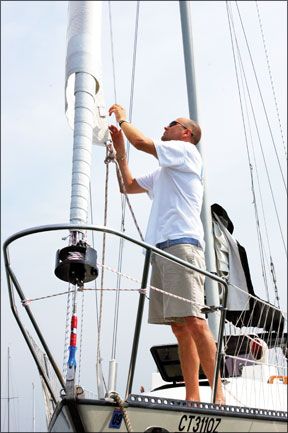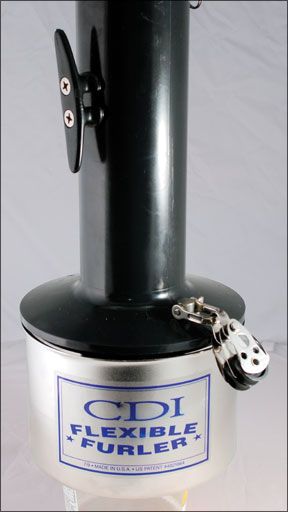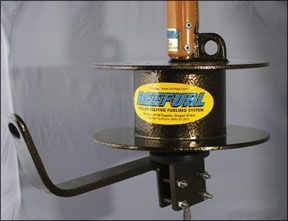The August issue spotlighted seven genoa furlers that use head swivels to get the job done. The top-rated products among them were the Harken Mark IV and US Spars Z-Spar Z-780, both recommended units, and our pick for Best Choice was Seldn Masts Furlex system. (See the Value Guide, page 19, for more on these.)
As a follow-up to that report, this months review examines four of the integral headsail furling systems that are on the market today. One of the big surprises in this test group is the trend toward the keep-it-simple side of roller furling-once the sole domain of Cruising Design Inc. Along with CDIs furler, we took a look at non-head-swivel furlers, suited for 30- to 35-foot sailboats, from Alado, Spin-Tec, and Reefurl. These represent both an evolution in engineering and strides forward in materials selection.

Photos by Ralph Naranjo
Having no upper halyard swivel, these units put the foil sections in compression and use an external halyard system to attach the head of the jib to a built-in halyard or a fitting at the top foil section. Spin-Tec has taken this design one step further by developing a hoist system with a foil-
riding device that hooks and unhooks the head of the sail to the uppermost foil.
How We Tested
Practical Sailor
Testers also inspected disassembled versions of the products, giving close scrutiny to system design and component manufacture.
Alado A2
In the February 2009 issue, we launched our long-term test of the Alado A2 furler and reported on its installation. A well-engineered example of a system lacking a top swivel, the Alado has given us a good benchmark by which to evaluate other non-halyard swivel systems.
One of Alados key selling points is that not only can the unit be installed with the mast up, but theres not even a need for anyone to go aloft during the install. Unique overlapping foil sections slide together and are easily fitted with bushings as they are pushed up the headstay using a mast halyard to do the not-so-heavy lifting. On our test furler, these light and streamlined foil sections still appear brand-new going into the second season.
The Alado earned Excellents for ease of installation and construction. Like all of the non head-swivel furlers tested, it earned a Good rating for performance.
Bottom line: Dealing with completely external halyards is a bit of a nuisance but by no means a show stopper. The ultra simplicity of the A2 and lack of complex moving parts make it appealing for DIY installation, especially for those with cruising sailboats in the 30- to 35-foot range. Its low price and lifetime warranty earn the Budget Buy spot.
Cruising Design Inc.
The Cruising Design Inc. Flexible Furler set the stage for integral furlers, and recent innovations have improved its operation. The ball-bearing drum option places compression and axial loads transmitted during furling to a ball-bearing cup that greatly reduces friction. The foil is a one-piece plastic extrusion that acts as an effective bushing, a bolt rope slot, and halyard hider. A molded-plastic foil cap is fitted with a turning block, and the halyard is slotted into the leading edge of the foil.

The CDI design has one drawback that should be seriously considered: The plastic foil extrusions are quite heavy and adding weight aloft does affect the righting moment of a boat. It earned a Good for construction.
However, it was quite easy to install and notched an Excellent in that category.
Bottom line: The simplicity of the installation and the limited number of parts make this unit an appealing design, but if your boat is already on the tender side and shy on ballast, a furling system with a lighter head foil should be considered.
Reefurl
If simplicity, a rugged yet functional approach to construction, and low cost float your boat, the Reefurl system deserves a good look. The hefty, round 1-inch-diameter foil sections are pop-riveted together with 3/16-inch stainless steel rivets. Theres no upper swivel and a welded fitting contains a small sheave for the external halyard that ties to the head of the jib with a bowline.
The drum rides on the headstay with thrust loads being countered by plastic washers and axial loads handled via a loose-fitting plastic tube positioned between the headstay and the drum. The same bushing segments are used in each foil segment all the way to the built in halyard.
The 5-inch inner and 10-inch outer diameters of the drum make it the largest we tested, affording more torque to compensate for the absence of a more sophisticated bearing system.
Because theres no rotating tack shackle or head swivel, the luff of the sail furls all at once and the sail shape of a deeply reefed headsail becomes a sailmakers challenge. Manufacturers literature claims that the system can turn a large genoa into a storm jib. Perhaps in terms of sail area, this is true, but the resulting shape, weight of material and massive leading edge does not result in an efficient storm sail.
The lengthy built-in fairlead helps keep the line evenly spaced on the drum and to some extent makes up for the lack of a cage or bar keepers that keep a loosened reefing line from falling off the drum.
The Reefurl earned across-the-board Goods for installation ease, construction quality, and performance.
Bottom line: The strong point of this no-frills furler is that there are few things to break, and if any do, repairs are very straight forward.
Spin-Tec
The Spin-Tec Triumph 2000 is another good example of simplicity and reliability in an integral furler. The elongated stainless-steel drum rides on a Delrin bushing that is fitted to the headstay turnbuckle.

The shiny drum assembly is fabricated from high-quality welded stainless, earning it an Excellent rating for construction quality. The drum is quite heavy, but with the added weight and bulk comes significant strength.
Aluminum U-channel links are used to join foil segments, and polyurethane glue (Gorilla Glue) holds the foil links in place. Torque loads radiate from foil to foil through these links. The glue, which expands as it cures, is designed to act as a bushing between the foil and the connector. Notches in the foils strengthen this connection. Were curious to see how years of use treat these glued junctions. Spin-Tec reported that some of these units have been in use aboard offshore cruisers for more than 15 years with the original glue still doing its job.
The Spin-Tec Triumph 2000 design has no permanent halyard attached to the hoisted genoa, which makes halyard wraps a non-issue but also makes setting and dousing the sail a bit of a chore with the standard setup. A crew must go aloft and shackle or unshackle the head of the sail to a bail at the top of the foil segments. The assumption is that if bad weather makes dousing difficult, you can always roll up the sail and wait to make the sail change.
We Much prefer Spin-Tecs optional setup, which incorporates an innovative halyard attachment accessory that is sold separately for $309. The accessory-a rectangular, plastic slide that rides along the foils like a train over tracks-allows the sail to be raised and lowered from the deck. To raise the genoa, a mast halyard is attached to the base of the slide and a shackle at the head of the sail is attached to the slides top via a hooked fitting. The slide (with sail attached) is hoisted to the top of the foils, where the hooked fitting catches a bail and releases itself from the slide. The slide is eased back down its foil track, and it and the halyard are removed. Dousing the sail is done via a similar hoist and unhook process. Spin-Tec offers a video of the unique process at www.spin-tec.com/pages/movie.html. The design shows some true ingenuity but accomplishing the feat at 0300 on a storm-tossed foredeck might be a different story.

Having a sail that can quickly and easily be doused in any weather is paramount, and Spin-Tec recommends all offshore boats purchase the halyard accessory. We recommend anyone buying the Spin-Tec furler purchase the optional halyard accessory because being able to dump a sail is important even in coastal waters where summer squalls can be violent.
The Triumph 2000 comes with a lifetime guarantee and a no-maintenance guarantee, good offers for such a pricey piece of gear.
Bottom line: The Spin-Tec is a high-quality, well-engineered furler, but wed like to see the optional accessory made standard.
Conclusion
We believe that theres no perfect system, but some of those tested were better than others. Non ball-bearing equipped furlers made up for some of their added friction by using larger-diameter drums, and the net effect is much like sailing with a longer tiller. The bottom line was that furling a non ball-bearing design took a little harder pull, but in the size range we tested, the pull was still completely acceptable. Those with bushings also require less maintenance.
CDI, with its bearing cup in the base of the furler unit and full-length plastic foil extrusion, was the easiest in this category to furl. Reefurl, with its large drum, and Spin-Tec with its vertical wrap approach were also easy enough to furl. Alado earned a good rating in this category.
With all products performing well, we looked to other qualities for our picks. In todays tight economic climate, a frugal sailor cannot ignore the value of dollars saved, and with three units selling for under $1,000, we felt this bargain end of the spectrum deserved serious attention. The final call was a tough one, but for us, the slide-together foils, and easy, no need to climb the mast, DIY installation earned the Alado A2 Practical Sailors recommendation and the title of the most cost-effective choice in this category.
However, when it comes to all-weather easy furling, the units with efficient ball bearings (August 2009) won out, and the Seldn Furlex remains our pick for Best Choice among the headsail furlers we tested.
conducted on-the-water performance tests of each system on various boats in 5- to 20-knot wind conditions. Testers considered how easily each system furled and unfurled the sail, and they evaluated sail shape and how easy it was to reef in a blow.

































